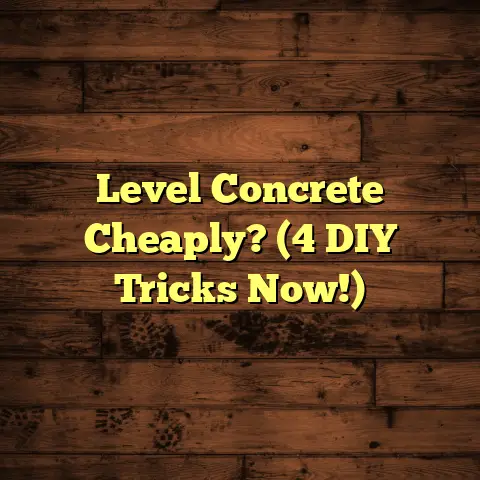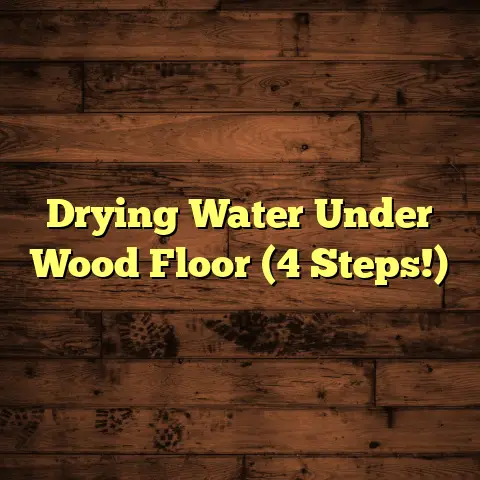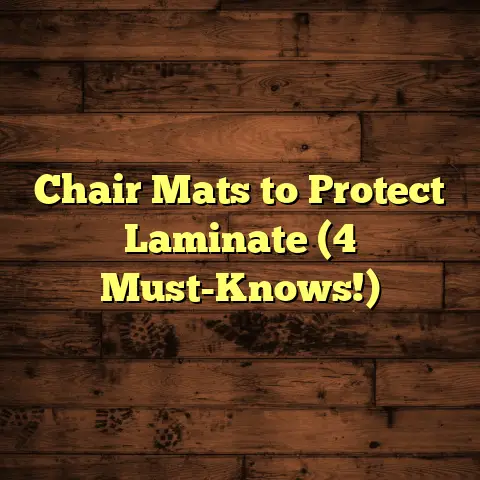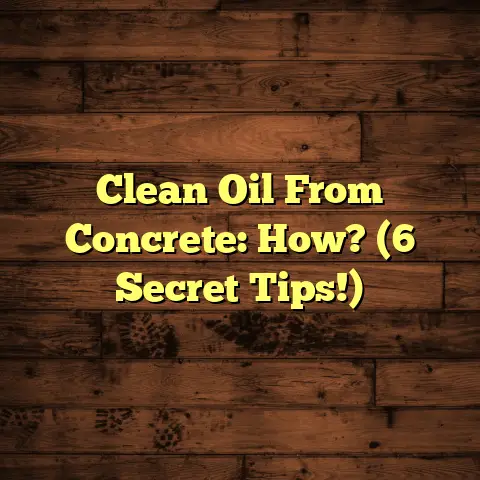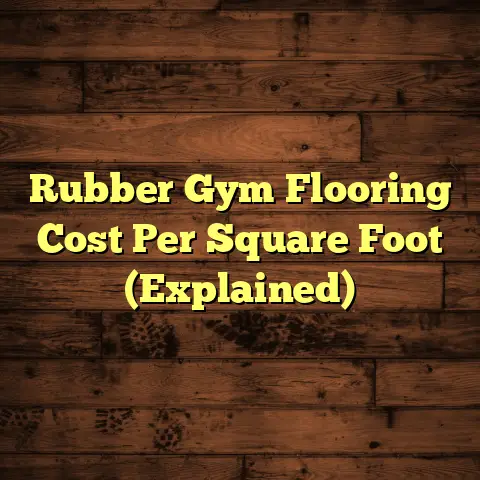Oil Spill SOS: Garage Floor Rescue! (3 Fixes Now!)
Garages, right? They’re not just for parking our cars. They’re workshops, storage units, hobby hubs – the unsung heroes of our homes.
I’ve seen garages morph into everything from wood-working shops to makeshift gyms. That’s why I know a thing or two about garage floors. We’re talking about concrete, epoxy, maybe even tiled surfaces. Tough stuff, usually.
But then comes the dreaded oil spill.
Ugh! It’s a common problem, especially with our trusty vehicles dripping fluids. Seems like a disaster, doesn’t it?
But don’t sweat it! I’m here to tell you that an oil-stained garage floor isn’t the end of the world.
In this article, I’m going to walk you through three effective fixes that I’ve used time and again to bring garage floors back from the brink.
Ready to get started? Let’s dive in!
Section 1: Understanding the Impact of Oil Spills on Garage Floors
1.1 The Nature of Oil Spills
Okay, let’s get down to brass tacks. How do these oil spills even happen in the first place?
Well, the most common culprit is our cars. Leaky gaskets, worn-out seals, even a simple oil change gone wrong can leave their mark.
I remember one time, a client swore his car wasn’t leaking a drop. Turns out, it was a tiny pinhole leak that sprayed oil only when the engine was hot. Tricky stuff!
Beyond cars, we’ve got lawnmowers, motorcycles, and other equipment that often call the garage home. Improper storage or maintenance can lead to drips and spills.
And let’s not forget about those DIY projects. Spilled paint thinner, grease, or even just plain old motor oil can quickly turn a clean floor into a messy eyesore.
1.2 Immediate Effects
So, you’ve got an oil spill. What happens next?
First, the obvious: the stain. That dark, unsightly patch that seems to scream, “I’m here to stay!”
But it’s not just about looks. Oil makes surfaces dangerously slippery. I’ve seen enough near-falls to know that safety is a real concern.
Plus, oil can start to degrade your flooring.
Concrete, while tough, is porous. Oil seeps in, weakening the structure over time.
Epoxy coatings can discolor and even lift if exposed to oil for too long.
1.3 Long-Term Consequences
Left untreated, oil spills can cause some serious headaches down the road.
For concrete floors, that seeping oil can eventually lead to cracks and crumbling.
I’ve seen garages where the concrete was so saturated with oil that it actually smelled like a gas station!
And it’s not just about the floor itself. Oil spills can create a fire hazard.
Plus, those fumes? Not exactly healthy to breathe in, especially in an enclosed space.
And let’s be honest, a stained, greasy garage floor just isn’t a pleasant place to be.
It can make the whole space feel dirty and uninviting.
Section 2: Preparation for the Rescue Mission
Alright, enough doom and gloom. Let’s get ready to tackle these spills head-on!
2.1 Safety First
Before you even think about grabbing a cleaning solution, safety needs to be your top priority.
First, ventilation is key. Open those garage doors and windows to get some fresh air circulating.
Those fumes can be nasty, so don’t skip this step!
Next, gear up. Gloves are a must to protect your skin from harsh chemicals.
I always recommend wearing eye protection too, just in case of splashes.
A mask is a good idea, especially if you’re dealing with strong-smelling cleaners.
And finally, keep kids and pets away from the area until the cleanup is complete. Safety first, always!
2.2 Tools and Materials Needed
Okay, now for the fun part – gathering our arsenal! Here’s a list of essentials:
- Absorbent Materials: Cat litter, sawdust, paper towels, or commercial oil absorbents.
- Scrub Brush: A stiff-bristled brush for scrubbing those stubborn stains.
- Cleaning Solutions: Degreasers, dish soap, or specialized concrete cleaners.
- Buckets: For mixing solutions and rinsing.
- Hose: For rinsing the floor after cleaning.
- Protective Gear: Gloves, mask, eye protection.
- Putty Knife or Scraper: For removing dried-on gunk.
- Sealer (Optional): For protecting the floor after cleaning (more on this later).
2.3 Assessing the Damage
Before you start scrubbing, take a good look at the spill. How big is it? How long has it been there?
Is it a fresh spill, or has it been sitting for weeks?
The answers to these questions will help you determine the best course of action.
For fresh spills, quick action is key. The sooner you soak up the oil, the less likely it is to stain.
For older stains, you might need to use a more aggressive cleaning solution or stain remover.
I usually start with the gentlest method first and work my way up to stronger solutions if needed.
Section 3: Fix #1 – Absorb and Clean
3.1 Immediate Response to Fresh Spills
Time is of the essence! When a spill happens, react fast.
Grab your absorbent material of choice. Cat litter is a classic, cheap option. Sawdust works well too.
I’ve even used shredded paper in a pinch.
Pour a generous amount of the absorbent material over the spill, making sure to cover it completely.
Let it sit for at least 30 minutes, or even longer for larger spills.
The absorbent material will soak up the oil, making it easier to clean up.
Once it’s absorbed as much as it can, sweep up the material and dispose of it properly.
Don’t just toss it in the trash! Check your local regulations for proper disposal of oil-soaked materials.
3.2 Cleaning Solutions
Now that you’ve absorbed the bulk of the oil, it’s time to tackle the remaining stain.
There are a few different cleaning solutions you can use.
A simple degreaser is a good starting point. You can find these at most hardware stores or auto parts stores.
Dish soap can also work in a pinch. Mix it with warm water to create a soapy solution.
For tougher stains, you might need a specialized concrete cleaner.
Follow the instructions on the product label carefully.
Apply the cleaning solution to the stain and let it sit for a few minutes.
Then, use your scrub brush to scrub the area vigorously.
3.3 Rinsing and Finishing Touches
Once you’ve scrubbed the stain, it’s time to rinse the area with clean water.
A hose works best for this, but you can also use a bucket and mop.
Make sure to rinse away all traces of the cleaning solution.
Once the floor is dry, take a look at the area. Is the stain gone? If not, you might need to repeat the cleaning process or try a different cleaning solution.
For a final touch, you can apply a concrete sealant to protect the floor from future spills.
Section 4: Fix #2 – Stain Removal Techniques
4.1 Identifying Stains
Not all oil stains are created equal. Some are fresh and easy to remove, while others have been lurking for years.
Different types of oil can also leave different types of stains.
Motor oil, for example, tends to leave a dark, greasy stain.
Brake fluid can leave a more reddish or brownish stain.
And transmission fluid can leave a lighter, almost clear stain.
Knowing what kind of stain you’re dealing with can help you choose the right cleaning method.
4.2 Chemical Stain Removers
For stubborn stains, you might need to bring out the big guns: chemical stain removers.
There are a variety of commercial stain removers available, specifically designed for removing oil stains from concrete.
These products typically contain strong solvents that dissolve the oil and lift it from the surface.
When using chemical stain removers, always follow the instructions on the label carefully.
Wear gloves and eye protection, and make sure the area is well-ventilated.
Apply the stain remover to the stain and let it sit for the recommended amount of time.
Then, scrub the area with a brush and rinse thoroughly with water.
4.3 DIY Solutions
If you’re looking for a more natural approach, there are a few DIY stain removal solutions you can try.
One popular method is to make a paste of baking soda and water.
Apply the paste to the stain and let it dry completely. Then, scrub the area with a brush and rinse with water.
Another option is to use a mixture of vinegar and water.
Vinegar is a natural degreaser that can help to break down oil stains.
Apply the vinegar solution to the stain and let it sit for a few minutes.
Then, scrub the area with a brush and rinse with water.
For really tough stains, you can try using a poultice.
A poultice is a mixture of absorbent material and a solvent that is applied to the stain and left to dry.
The absorbent material draws the oil out of the concrete, while the solvent helps to dissolve it.
One common poultice recipe is to mix diatomaceous earth with a solvent like acetone or mineral spirits.
Apply the poultice to the stain and cover it with plastic wrap.
Let it dry completely, which can take several days.
Then, scrape off the dried poultice and rinse the area with water.
Section 5: Fix #3 – Sealing and Protecting the Garage Floor
5.1 Importance of Sealing
You’ve cleaned up the oil spill, and your garage floor looks great. But your work isn’t quite done yet.
Sealing your garage floor is crucial for protecting it from future spills and damage.
A good sealant will create a barrier that prevents oil and other fluids from penetrating the concrete.
This will make it much easier to clean up spills in the future and prevent stains from setting in.
Sealing your garage floor can also help to prevent cracks and crumbling.
Concrete is porous, which means it can absorb water and other liquids.
When these liquids freeze and thaw, they can cause the concrete to crack and crumble.
A sealant will help to prevent this from happening by keeping the concrete dry.
5.2 Choosing the Right Sealant
There are several different types of sealants available for garage floors.
Epoxy sealants are a popular choice because they are durable, chemical-resistant, and easy to apply.
Epoxy sealants create a hard, glossy finish that is resistant to stains and scratches.
However, epoxy sealants can be expensive, and they can be slippery when wet.
Polyurethane sealants are another good option.
They are also durable and chemical-resistant, but they are more flexible than epoxy sealants.
This makes them a good choice for garages that experience a lot of movement or vibration.
Acrylic sealants are a more affordable option. They are not as durable as epoxy or polyurethane sealants, but they are still effective at protecting your garage floor from spills and stains.
5.3 Application Process
Before you apply any sealant, make sure the floor is clean and dry.
Remove any dirt, dust, or debris with a broom or vacuum cleaner.
If there are any oil stains, clean them with a degreaser or stain remover.
Once the floor is clean, you can start applying the sealant.
Follow the instructions on the product label carefully.
Most sealants are applied with a roller or brush.
Apply a thin, even coat of sealant to the floor.
Let the sealant dry completely before applying a second coat.
The drying time will vary depending on the type of sealant you use.
Once the sealant is dry, your garage floor will be protected from future spills and damage.
Section 6: Preventive Measures for Future Oil Spills
6.1 Regular Maintenance
The best way to prevent oil spills is to keep your vehicles in good working order.
Regularly check your car for leaks and have them repaired promptly.
Pay attention to any warning lights on your dashboard, and take your car in for service when needed.
Change your oil regularly, and make sure to tighten the drain plug properly.
Inspect your hoses and belts for wear and tear, and replace them as needed.
6.2 Design Considerations
When designing your garage, consider incorporating features that can help to prevent oil spills.
Install a floor drain to allow spills to be easily washed away.
Use floor mats to protect the concrete from spills and stains.
Create a designated area for working on your car, and keep it separate from other areas of the garage.
6.3 Education and Awareness
Make sure everyone in your household knows how to prevent and clean up oil spills.
Teach them how to properly dispose of used oil and other fluids.
Encourage them to report any leaks or spills immediately.
By working together, you can keep your garage floor clean and safe for everyone.
Conclusion
So, there you have it! Three effective fixes for tackling those dreaded oil spills on your garage floor.
Remember, while oil spills can be frustrating, they’re definitely manageable with the right approach and tools.
Your garage is more than just a place to park your car; it’s an extension of your home, a space for hobbies, projects, and sometimes, just a little tinkering.
Taking the time to restore and protect your garage floor is an investment in the functionality and enjoyment of your entire home.
Don’t let those stains win! Take action, use these fixes, and reclaim your garage as a safe, functional, and clean environment.
You’ve got this!

